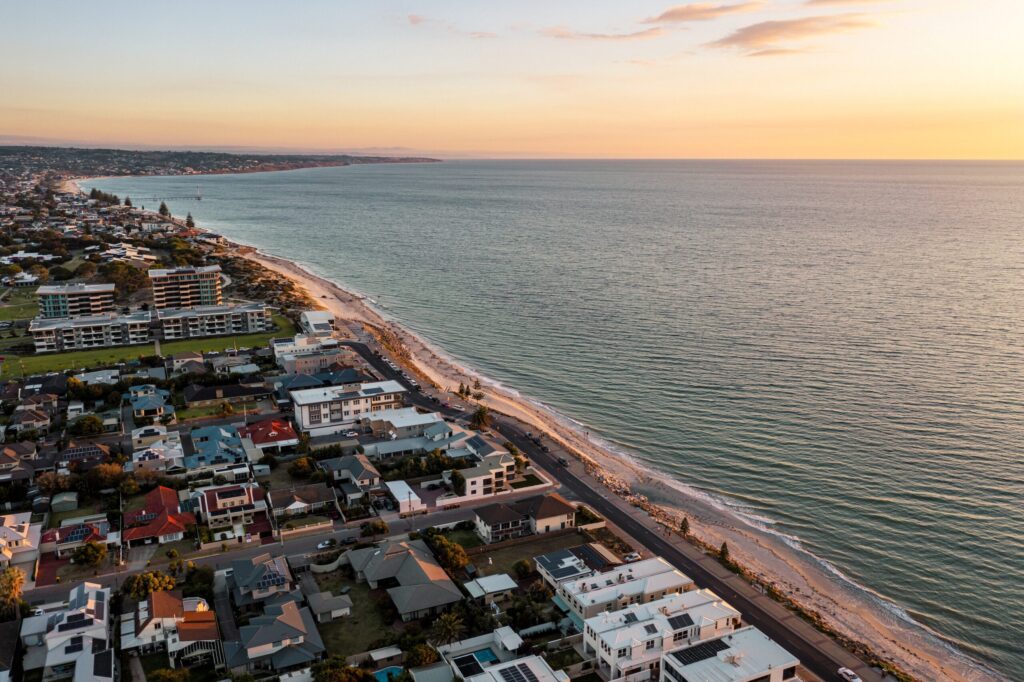
Aerial view of Brighton Beach coastline in Adelaide, SA, Australia at sunset
The dream of relocating to another Australian city has become increasingly complex, as soaring housing prices challenge the financial viability of such moves. Many Melburnians, seeking a change after the extensive COVID-19 lockdowns of 2020 and 2021, are now facing a shifting property landscape that complicates their plans.
During the pandemic, tens of thousands left Melbourne, which had some of the highest property prices among Australian capitals, trailing only behind Sydney. However, homes in smaller capital cities like Brisbane, Adelaide, and Perth have recently surged in value, pushing Melbourne down in the rankings of affordable cities. This trend is evident in the latest data from PropTrack, which reveals that national home prices reached a record high of $827,000 in July 2025, marking an increase of 4.3% over the past year.
Shifting Property Values
The recent PropTrack Home Price Index highlights the median home values across different capital cities. Sydney remains at the top with a median dwelling price of $1,194,000, followed by Brisbane at $919,000 and Perth at $847,000. In comparison, Melbourne’s median home value has dropped to $824,000.
As the data indicates, selling a home in Sydney or Melbourne no longer guarantees a significant upgrade in smaller capitals. For instance, a recent sale in Melbourne’s Yarraville neighborhood saw a family home fetch $1.025 million. In Brisbane’s Clayfield, a comparable property sold for $1.06 million, underscoring a trend where city-switchers may only find similar homes rather than improved living conditions.
According to Anne Flaherty, senior economist at REA Group, “For someone looking to rent or buy a home, Melbourne is more cost-effective than other states right now.” This shift reflects Melbourne’s status as Australia’s second-largest economy, attracting those seeking job opportunities and educational prospects.
Migration Patterns and Future Trends
Despite the appeal of moving to other capitals, recent data from the Australian Bureau of Statistics shows that more people are leaving Melbourne than moving there. In the year leading up to June 2024, only Brisbane and Perth recorded net internal migration gains. The implications of this trend mean that relocators may not receive the expected value for their properties, as the demand in booming cities continues to drive prices up.
The situation differs for Adelaide, which experienced a positive net interstate migration during the pandemic for the first time in a decade. Ms. Flaherty noted that many former Melburnians returned to Adelaide, putting pressure on rental markets and home buying.
In contrast, Hobart, which has seen a significant price correction, remains one of the most affordable capital cities, closely followed by Darwin. Hobart’s home values are approximately 7.5% below their peak, making it an attractive option for buyers seeking affordability. For the same $1.02 million price as the Yarraville home, a buyer could acquire a spacious family residence within 4 kilometers of Hobart’s CBD.
Darwin, on the other hand, offers the most affordable capital city homes, with typical property values less than half those in Sydney. The Northern Territory capital has also seen a surge in investor interest, with lending for property purchases increasing by nearly 20% in the second quarter of 2025 compared to the previous year.
As ANZ projects a total price increase of 14.3% for Darwin homes this year, followed by an additional 6.1% in 2026, it suggests a promising outlook for property investment in the region.
The evolving dynamics of the Australian property market indicate that moving cities is no longer a straightforward path to greater affordability. As housing prices continue to shift, potential relocators must carefully assess their options and the economic realities of their chosen destinations.







